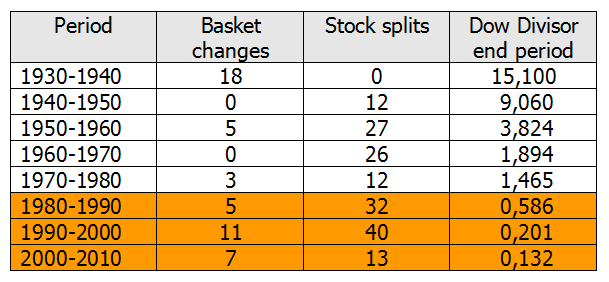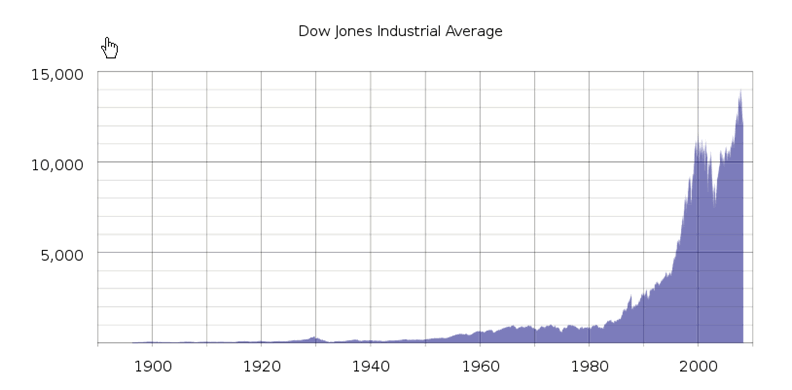Dow Jones Stocks Index - A Hoax or Not A Hoax, That's the Question
Stock-Markets / Stock Index Trading Apr 02, 2014 - 03:15 PM GMTBy: Wim_Grommen
 After intensive consultation with his advisors, President Obama has decided to modify the formula used for calculating the Dow Jones Index. On January 1, 2015 the Dow Divisor will be changed to 30. The result of this change will be that the Dow Jones Index drops from the current 16532 points to about 85.8 points. The underlying value of the 30 component stocks of course remains unchanged. With this modification to the formula Obama aims to make the large Dow fluctuations of recent decennia a thing of the past, and hopes that this will bring stability to the stock market. Banks, major investors and pension funds welcome this change in the Dow Jones Index formula.
After intensive consultation with his advisors, President Obama has decided to modify the formula used for calculating the Dow Jones Index. On January 1, 2015 the Dow Divisor will be changed to 30. The result of this change will be that the Dow Jones Index drops from the current 16532 points to about 85.8 points. The underlying value of the 30 component stocks of course remains unchanged. With this modification to the formula Obama aims to make the large Dow fluctuations of recent decennia a thing of the past, and hopes that this will bring stability to the stock market. Banks, major investors and pension funds welcome this change in the Dow Jones Index formula.
To understand Obama’s proposal we must go back in Dow Jones history. The Dow was first published in 1896. The Dow was calculated by dividing the sum of the 12 component company stocks by 12:
Dow-index_1896 = (x1 + x2+ ..........+x12) / 12
In 1916 the Dow was enlarged to 20 companies; 4 were removed and 12 added:
Dow-index_1916 = (x1 + x2+ ..........+x20) / 20
The shares of a number of companies were split in 1927, and for those shares a weighting factor was introduced in the calculation. The formula is now as follows
(x1 = American Can is multiplied by 6, x2 = General Electric by 4 etc. )
Dow-index_1927 = (6.x1 + 4.x2+ ..........+x20) / 20
On 1 October 1928 the Dow was further enlarged to 30 stocks. Because everything had to be calculated by hand, the index calculation was simplified. The Dow Divisor was introduced. The index was calculated by dividing the sum of the share values by the Dow Divisor. In order to give the index an uninterrupted graph the Dow Divisor was given the value 16.67.
Dow-index_Oct_1928 = (x1 + x2+ ..........+x30) / Dow Divisor
Dow-index_Oct_1928 = (x1 + x2+ ..........+x30) / 16.67
Since then the Dow Divisor has acquired a new value every time there has been a change in the component stocks, with a consequent change in the formula used to calculate the index. This is because at the moment of change the results of two formulas based on two different share baskets must give the same result. When stocks are split the Dow Divisor is changed for the same reason.
In autumn 1928 and spring 1929 there were 8 stock splits, causing the Dow Divisor to drop to 10.47.
Dow-index_Sep_1929 = (x1 + x2+ ..........+x30) / 10.47
After the stock market crash of 1929, 18 companies were replaced in the Dow and the Dow Divisor got the value 15.1.

Table: Changes in the Dow, stock splits and Dow Divisor
The table above makes it clear that the Dow Jones formula has been changed many times and that the Dow Divisor in the period 1980-2010 has actually become a Dow Multiplier, due to the large number of stock splits in that period. Where in the past the sum of the share values was divided by the number of shares, nowadays the sum of the share values multiplied by 6.4 . Dividing by 0.15571590501117 is after all the same as multiplying by 6.4 . (1 / 0,1557 = 6.4). This partly explains the behaviour of the Dow graph since 1980.

Figure: the Dow Jones since 1896
The proposed change on 1 January 2015 restores the formula to what it originally was: the sum of the share values divided by the number of component shares.
Dow-index_Jan_2015 = (x1 + x2+ ..........+x30) / 30
The aggregate current value of the 30 component stocks is 2574 dollars. By changing the Dow Divisor from 0.15571590501117 to 30 (a factor 192 larger) the index will, at current values, change from 15658 to 85.8 points (a factor 192 smaller).
The emotional factor in the current formula, the nervousness or euphoria of investors resulting from large fluctuations in the Dow, will be greatly reduced by this change (192 times) and so rationality should gain the upper hand in investor’s decisions.
Obama’s proposed change must still be approved by House and Senate. Both Republicans and Democrats have told Obama they support his proposal. Politicians, irrespective of political colour, desire stability in the stock markets. For the investor however it will take some getting used to: the Dow Jones at 85.8 points.
Wim Grommen is a guest contributor to http://www.FinancialArticleSummariesToday.com, “A site/sight for sore eyes and inquisitive minds”, and www.munKNEE.com, “It’s all about MONEY” of which Lorimer Wilson is editor.
© 2014 Copyright Wim Grommen - All Rights Reserved
Disclaimer: The above is a matter of opinion provided for general information purposes only and is not intended as investment advice. Information and analysis above are derived from sources and utilising methods believed to be reliable, but we cannot accept responsibility for any losses you may incur as a result of this analysis. Individuals should consult with their personal financial advisors.
© 2005-2022 http://www.MarketOracle.co.uk - The Market Oracle is a FREE Daily Financial Markets Analysis & Forecasting online publication.



